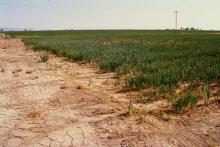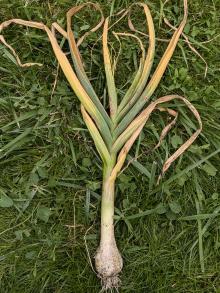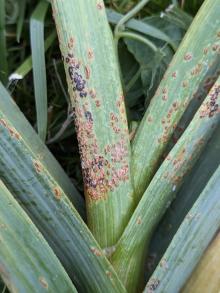Cause Puccinia allii on garlic, onion and wild Allium species. This fungus has caused major epidemics in California and losses in Arizona and Oregon. California isolates did not infect leek, shallot or elephant garlic. However, P. allii in Europe is extremely damaging on leek.
This fungus may overwinter on volunteer garlic and onions, or on wild hosts. When seed cloves, collected from rust-infected garlic plants, were planted (studies by the University of California), none of the plants that grew from these cloves developed rust. The rust is autoecious, and same-season reinfection by urediniospores is common. Severe losses are reported when rain, fog, or irrigation are excessive. Infection rates are highest at cool temperatures (50°F to 59°F) and 100% relative humidity; at least 4 hours of leaf wetness is required for infection. Temperatures below 50°F and above 75°F inhibit the disease. No resistant garlic lines have been identified.
Symptoms Initial symptoms include small white to yellow flecks and spots. The spots enlarge and become oval to elongate or diamond shaped and take on an orange cast as uredinia develop. Later in the season, black oval to elongate telia develop. These telia may or may not break through the epidermis. Telia of a related species, P. asparagi, found occasionally on onion, tend to be dark brown rather than black. Heavily infected plants have an orange cast, outer leaves may yellow and wither prematurely, and bulb size may be reduced.
Cultural control
- Rotate out of Allium crops for 2 to 3 years and destroy all volunteers and Allium weeds.
- Avoid consecutive plantings of garlic or onion.
- Plow under infected plant residues.
- Avoid dense plantings which favors disease.
- Avoid over application of nitrogen, which enhances infections.
- Avoid wetting of the leaves.
Chemical control
- Badge SC (Group M1) at 0.75 to 2.75 pints/A on 7- to 10-day intervals. Preharvest interval is 0 days. 24-hr reentry for greenhouse use; 48-hr reentry for all other applications.
- Demethylation-inhibiting (DMI) Fungicides (Group 3) are labeled for use.
- Tebuzol 3.6F at 4 to 6 fl oz/A on 7- to 14-day intervals. Do not apply within 7 days of harvest. 12-hr reentry.
- Dithane F-45 Rainshield at 2.4 quarts/A on 7-day intervals. Do not apply to exposed bulbs. Do not apply within 7 days of harvest. 24-hr reentry.
- OSO 5% SC (Group 19) at 3.75 to 13 fl oz/A on 7- to 14-day intervals. Can be applied the day of harvest. 4-hr reentry. O
- Strobilurin fungicides (Group 11) are labeled for use. Do not make more than one (1) application of a Group 11 fungicide before alternating to a labeled fungicide with a different mode of action.
- Quadris Flowable at 6 to 12 fl oz/A. May be applied the day of harvest. 4-hr reentry.
- Sulfur formulations are registered for garlic (Microthiol Disperss O, Sulfur 6L, etc.) for other diseases and will aid in controlling rust. Sulfur is fungitoxic in its vapor phase and, therefore, is effective only when air temperatures promote volatilization. Sulfur volatilizes above 65°F but becomes phytotoxic above 95°F. Using it above 85°F is not recommended. Although sulfur reduces sporulation of established infections, it is primarily a protectant and must be applied before infection. Begin applying when weather conditions are appropriate and continue at weekly intervals. See label for details on rates and reentry intervals.
Note: Premixes of fungicides are available for use. Make only one (1) application of a Group 3 or Group 11 fungicide before rotating to a different mode of action.
- Dexter Max (Group M3 + 11) at 3.2 lb/A on 7-day intervals. Do not apply to exposed bulbs. Preharvest interval is 7 days. 24-hr reentry.
- Dexter Xcel (Group M3 + 11 + 3) at 48 to 72 fl oz/A on 7- to 10-day intervals. Do not apply to exposed bulbs. Preharvest interval is 7 days. 24-hr reentry.
- Quilt Xcel (Group 3 + 11) at 14 to 21 fl oz/A on 7- to 10-day intervals. Do not apply within 14 days of harvest. 12-hr reentry.
- Trivapro (Group 3 + 7 + 11) at 16 to 27.7 fl oz/A on 7- to 14-day intervals. Preharvest interval is 7 days for bulb onions and 14 days for green onions. 12-hr reentry.
Biological control Efficacy in the Pacific Northwest is unknown.
- Double Nickel LC at 0.5 to 4.5 pints/A on 3- to 10-day intervals. Can be applied the day of harvest. 4-hr reentry. O
References Koike, S.T., Gladders, P., and Paulus, A.O. 2007. Vegetable Diseases: A Color Handbook. St. Paul. MN: APS Press.
Schwartz, H.F., and Mohan, S.K. 1995. Compendium of Onion and Garlic Diseases. St. Paul. MN: APS Press.





